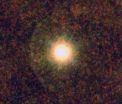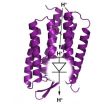(Press-News.org) ESA's Herschel infrared space observatory has discovered that ultraviolet starlight is the key ingredient for making water in space. It is the only explanation for why a dying star is surrounded by a gigantic cloud of hot water vapour.
Every recipe needs a secret ingredient. When astronomers discovered an unexpected cloud of water vapour around the old star IRC+10216 in 2001, they immediately began searching for the source. Stars like IRC+10216 are known as carbon stars and are thought not to make much water. Initially they suspected the star's heat must be evaporating comets or even dwarf planets to produce the water.
Now, Herschel's PACS and SPIRE instruments have revealed that the secret ingredient is ultraviolet light, because the water is too hot to have come from the destruction of icy celestial bodies.
"This is a good example of how better instruments can change our picture completely," says Leen Decin, Katholieke Universiteit Leuven, Belgium, the lead author of the paper about this work. The superb sensitivity of Herschel's instruments has revealed that the water around IRC+10216 varies in temperature from about �°C to 800°C, which indicates that it is being formed much closer to the star than comets can stably exist.
IRC+10216 is a red giant star, hundreds of times the Sun's size, although only a few times its mass. If it replaced the Sun in our Solar System, it would extend beyond the orbit of Mars.
It is 500 light years away and while it is barely detectable at visible wavelengths, even in the largest telescopes, it is the brightest star in the sky at some infrared wavelengths. This is because it is surrounded by a huge envelope of dust that absorbs almost all its visible radiation and re-emits it as infrared light. It is in the envelope that the water vapour has been found. But how did the water get there?
The vital clue was found by Herschel. Observations had already revealed the clumpy structure in the dusty envelope around IRC+10216. The Herschel water detection made the astronomers realise that ultraviolet light from surrounding stars can reach deep into the envelope between the clumps and break up molecules such as carbon monoxide and silicon monoxide, releasing oxygen atoms. The oxygen atoms then attach themselves to hydrogen molecules, forming water.
"This is the only mechanism that explains the full range of the water's temperature," says Decin. The closer to the star the water is formed, the hotter it will be.
Decin and her colleagues now plan to extend the observations to other carbon stars. "We are very hopeful that Herschel will find the same situations around those stars too," she says.
On Earth, carbon compounds and water are the key ingredients for life. Now, thanks to Herschel, we know that both can be made around IRC+10216, and that the secret ingredient for water is ultraviolet light from surrounding stars.
INFORMATION:
Recipe for water: Just add starlight
2010-09-04
ELSE PRESS RELEASES FROM THIS DATE:
Long term use of oral bisphosphonates may double risk of esophageal cancer
2010-09-04
People who take oral bisphosphonates for bone disease over five years may be doubling their risk of developing oesophageal cancer (cancer of the gullet), according to a new study published on bmj.com today.
Oral bisphosphonates are a type of drug used to treat osteoporosis and other bone diseases and are the most commonly recommended treatment for such conditions.
Case reports suggest an association between use of oral bisphosphonates for osteoporosis and increased risk of oesophageal cancer. But the evidence is limited, and no adequately large study with information ...
Roll-out of electronic patient records likely to be a long and complex process
2010-09-04
Interim results from the first comprehensive evaluation of the implementation of electronic health records in secondary care in England have found delays and frustration with the system, according to research published on bmj.com today.
The authors, led by Professor Aziz Sheikh from The University of Edinburgh (and which included researchers from The London School of Economics and Political Science, The School of Pharmacy and The University of Nottingham), say experiences from the first-wave implementation site "indicate that delivering improved healthcare through nationwide ...
Scientists unwrap DNA packaging to gain insight into cells
2010-09-04
Scientists have built a clearer picture of how lengthy strands of DNA are concertinaed when our cells grow and divide, in a discovery could help explain how cell renewal can go wrong.
Scientists have identified thousands of proteins that play a key role in compacting DNA – a crucial process by which DNA is shortened up to 10,000 times to fit inside cells as they split into two.
Researchers hope the findings could shed light on what happens when this packaging process fails and cells divide abnormally – which can lead to cancer or cause developing embryos to miscarry.
Scientists ...
Bochum's researchers discover proton diode
2010-09-04
Biophysicists in Bochum have discovered a diode for protons: just like the electronic component determines the direction of flow of electric current, the "proton diode" ensures that protons can only pass through a cell membrane in one direction. Water molecules play an important role here as active components of the diode. The researchers led by Prof. Dr. Klaus Gerwert (Chair of Biophysics at the RUB) were able to observe this through a combination of molecular biology, X-ray crystallography, time-resolved FTIR spectroscopy and biomolecular simulations. They report in the ...
Head start for migraine sufferers
2010-09-04
For severe migraine sufferers, psychological treatments build on the benefits of drug therapy, according to a new study1 by Elizabeth Seng and Dr. Kenneth Holroyd from Ohio University in the US. Their comparison of the effects of various treatment combinations for severe migraine – drug therapy with or without behavioral management – shows that those patients receiving the behavioral management program alongside drug therapy are significantly more confident in their ability to use behavioral skills to effectively self-manage migraines. And surprisingly, the increase in ...
Ancient brew masters tapped antibiotic secrets
2010-09-04
A chemical analysis of the bones of ancient Nubians shows that they were regularly consuming tetracycline, most likely in their beer. The finding is the strongest evidence yet that the art of making antibiotics, which officially dates to the discovery of penicillin in 1928, was common practice nearly 2,000 years ago.
The research, led by Emory University anthropologist George Armelagos and medicinal chemist Mark Nelson of Paratek Pharmaceuticals, Inc., is in the current issue of the American Journal of Physical Anthropology.
"We tend to associate drugs that cure diseases ...
Connection between light at night and cancer revealed in additional study
2010-09-04
A new study from the Center for Interdisciplinary Chronobiological Research at the University of Haifa has found an additional link between Light At Night (LAN) and cancer. This research joins a series of earlier studies carried out at the University of Haifa that also established the correlation. "High power light bulbs contribute more to 'environmental light pollution', which the study has shown is a carcinogenic pollution," notes Prof. Abraham Haim, who headed the study.
Earlier studies in which Prof. Haim has participated at the University of Haifa, have shown that ...
Listening to ancient colors
2010-09-04
A team of McGill chemists have discovered that a technique known as photoacoustic infrared spectroscopy could be used to identify the composition of pigments used in art work that is decades or even centuries old. Pigments give artist's materials colour, and they emit sounds when light is shone on them.
"The chemical composition of pigments is important to know, because it enables museums and restorers to know how the paints will react to sunlight and temperature changes," explained Dr. Ian Butler, lead researcher and professor at McGill's Department of Chemistry. Without ...
EMAS publishes position statements about the post-reproductive health of women
2010-09-04
Amsterdam, 2 September, 2010 - Elsevier announced today the publication of four important position statements from the European Menopause and Andropause Society (EMAS) in the journal Maturitas (http://www.maturitas.org/) on common management problems in the post-reproductive health of women. The statements cover the management of the menopause in the context of obesity, epilepsy, endometriosis and premature ovarian failure. Each statement has summary recommendations as a quick aid for the busy clinician.
"The expanding ageing female population means that clinicians ...
New climate change mitigation schemes could benefit elites rather than the rural poor
2010-09-04
Oaxaca, Mexico (3 September 2010)—With governments across Latin America preparing to implement a new financial mechanism aimed at mitigating climate change by curbing carbon emissions from the destruction of tropical forests, experts gathering here today warned against a "one-size-fits-all" approach, calling instead for flexible, balanced solutions to the thorny dilemmas surrounding this new mechanism. Among the experts' chief worries is that the wealthy and powerful could capture many of the benefits, largely at the expense of rural communities, including indigenous groups. ...

